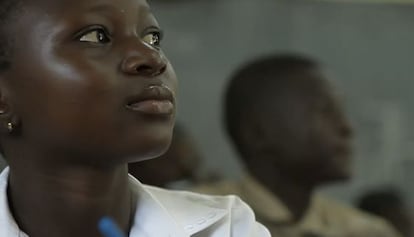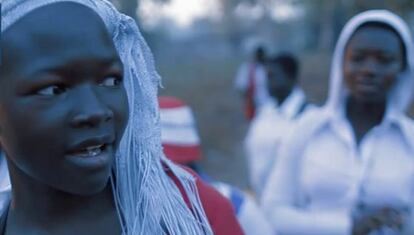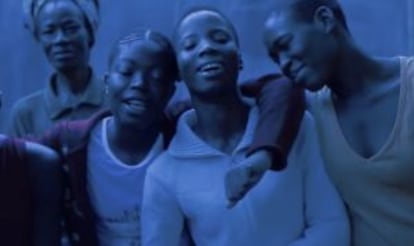The curse of Togo’s child-witches
A missionary group is raising awareness about children accused of witchcraft in the African country

They play, they run, they jump, they climb on swings and they hang from handrails, just like other children their age.
But these are the “child-witches” who live at Don Bosco, a shelter run by the Salesian missionaries in Togo.
No exact figures exist on how many children are being branded as witches, but their numbers are rising at the same pace as the rise in poverty around them. In the region of Kara alone, in the north of Togo, 773 minors were accused of witchcraft in 2013 according to the government’s regional social-action department.
Witchcraft is rooted in their most ancestral traditions, as is the case in other parts of Africa
The children are blamed by neighbors and even their own families for everything from disease to death, a bad harvest or the loss of a job. And this leads to neglect, abuse and even murder.
This reality is captured in a new report by Misiones Salesianas (or, The Salesian Society) a Roman Catholic group that is active in missionary work. “Minors accused of witchcraft in the region of Kara” was presented to the Spanish media as part of a broader campaign called Yo no soy bruja (or, I am not a witch), which also includes a short documentary on the subject by the Goya-winning director Raúl de la Fuente.
Togo, a small country between Ghana and Benin, is home to more than 40 ethnic groups, for whom animism is a fundamental part of their culture. And witchcraft is rooted in their most ancestral traditions, as is the case in other parts of Africa.

With a population of seven million, a life expectancy of 56 and per capita income of €479, Togo ranks near the bottom of the Human Development Index, coming in 166th out of 187 states.
The economy is based on subsistence agriculture, which is being hard hit by climate change, deforestation and the use of chemical fertilizers that reduce the extension of cultivated land. All of this leads to increased poverty levels, and with it higher rates of disease and mortality due to a lack of basic sanitation.
But locals end up believing that an evil spirit is deliberately hurting their family, the report explains.
Locals end up believing an evil spirit is deliberately hurting their family, the report explains
“It’s very easy to understand: the greater the poverty, the greater the number of deaths, and the more deaths, the more culprits that need to be found,” explains the missionary José Luis de la Fuente, director of the Don Bosco shelter for the last eight years and co-author of the report.
“Witchcraft is the ability to hurt another person through the spiritual world because this person is possessed by an evil spirit. This spirit eats the soul of the person being attacked. Its manifestation in the physical world is through disease, death, or social and economic ostracism,” says Patricia Rodríguez, who lived in the Kara region for two years and co-authored the report.
The victims of witchcraft accusations typically come from the most vulnerable segments of society: the elderly, widows, orphans and children who do not live with their families.

“Anyone who is different,” adds De la Fuente, whose center provides a home for around 110 children. Of these, 40 percent were accused of witchcraft last year. “When there are several deaths or diseases in the same family, relatives look for the culprit within the clan. If there is a child living with his or her stepmother, she will blame this child, which is not hers.”
This is what happened to Georgette, who shows her deformed hands in the documentary. She has been this way ever since her stepmother forced her to dunk her hands in boiling water to prove that she was not a witch. Inevitably, she sustained terrible burns that left doctors with no option but to amputate most of her fingers.
“One day my father called me to ask me whether I had the devil inside, I said I didn’t know, and he replied that if I didn’t tell him the truth he would kill me,” explains Georgette, who is now studying the equivalent of the third grade.
She told her father that she was possessed to prevent a beating, and her stepmother had the idea of the boiling water. When relatives saw her state they tried to take her to the hospital, but her father refused: “He said it was better for me to die because if I recovered I would destroy them.”
“This child is very smart, she is the only one in her family who was making any progress, and that is why her stepmother branded her as a witch,” explains De la Fuente.
The victims of witchcraft accusations typically come from the most vulnerable segments of society
Those who stand out from the rest, for better or for worse, tend to bear the brunt of the accusations: “Those who get very good grades and eclipse the rest, those who refuse to study, those who steal, those who are a little more aggressive or tend to lie a little more than the rest...” the shelter director explains.
Togo, just like other African countries, has abundant legislation protecting children, partly thanks to pressure from the international community. But it is quite common to see a clash between official laws and clan law.
“In practice, people do not use the courts too much; instead they try to settle conflicts using traditional justice,” says Patricia Rodríguez. According to another report by the Catholic charity Cáritas, 31.4 percent trust the justice of their clan leaders more than they trust the nation’s courts.
This traditional system nearly cost Rosalie her life. One day, she got into a fight with a group of girls over water, and she threatened to beat them up. Two weeks later, one of those girls got sick, and everyone pointed the finger of blame at Rosalie, who was brought before the head of the canton and told to drink a remedy. “If I was innocent, I would survive, and if I wasn’t, I would die,” she recalls. That was when she got in touch with the missionaries.
This child is very smart, and that is why her stepmother branded her as a witch”
The head of the canton often has an advisor known as a charlatan or knaw in the local language. This individual is allegedly clairvoyant, can see into the spiritual world and possesses the power to exorcise the evil spirits residing within child-witches.
In practice, the knaw inflicts bodily damage on the accused by forcing them to do things like drink poison. Sometimes he will take the victims away for months at a stretch, forcing them into semi-slavery and subjecting them to physical abuse. Additionally, these alleged “cures” are not free of charge, so that the charlatan ends up making a small fortune by abusing his “patients.”
The impact of these accusations is tremendous for the victims. Child-witches are stigmatized for the rest of their lives. The Salesian missionaries’ report underscores the psychological damage, which ranges from learning problems to social isolation, aggressive behavior, depression, post-traumatic stress, anxiety and personality disorders. As untreated adults, they run the risk of reliving the violent behavior of their past.
Many victims do not tell others about their problem, which makes it harder to find and treat them. Eventually, many end up on the streets, living off petty theft, doing drugs and joining criminal gangs.
The report’s recommendations include reforming Togo’s legislation to make accusations of witchcraft an aggravating factor in crimes against children. “In Togo, the punishment for child abuse is only seven days of community work,” says Rodríguez.
Many of these children end up on the streets, living off petty theft, doing drugs and joining criminal gangs.
The authors also ask for the international community to keep pressuring local authorities to combat these practices. Clan leaders have already met with international representatives to discuss the matter, but solutions are going to be long-term.
“Traditional leaders are not going to come up with quick solutions, but slowly they will seek deeper reasons for their community’s problems, before blaming a child of witchcraft,” says De la Fuente. “But the change will not be easy, because the leaders may tell the social services that they are cooperating, but they will have a lot of pressure back home to keep things they way they are.”
Georgette and Rosalie were lucky. The former dreams of being the ambassador of Togo in Germany. The latter is going to start business studies this year and she wants to be an accountant. But getting there will not be easy.
“The stigma always remains,” says De la Fuente. “When something like this happens to you as a child, no matter how much you change, part of it will remain with you forever.”
Tu suscripción se está usando en otro dispositivo
¿Quieres añadir otro usuario a tu suscripción?
Si continúas leyendo en este dispositivo, no se podrá leer en el otro.
FlechaTu suscripción se está usando en otro dispositivo y solo puedes acceder a EL PAÍS desde un dispositivo a la vez.
Si quieres compartir tu cuenta, cambia tu suscripción a la modalidad Premium, así podrás añadir otro usuario. Cada uno accederá con su propia cuenta de email, lo que os permitirá personalizar vuestra experiencia en EL PAÍS.
¿Tienes una suscripción de empresa? Accede aquí para contratar más cuentas.
En el caso de no saber quién está usando tu cuenta, te recomendamos cambiar tu contraseña aquí.
Si decides continuar compartiendo tu cuenta, este mensaje se mostrará en tu dispositivo y en el de la otra persona que está usando tu cuenta de forma indefinida, afectando a tu experiencia de lectura. Puedes consultar aquí los términos y condiciones de la suscripción digital.
Últimas noticias
The complicated life of Francesca Albanese: A rising figure in Italy but barred from every bank by Trump’s sanctions
Half of Scotland is in the hands of 420 property owners
Reinhard Genzel, Nobel laureate in physics: ‘One-minute videos will never give you the truth’
Pinochet’s victims grapple with José Antonio Kast’s rise in Chile
Most viewed
- Pablo Escobar’s hippos: A serious environmental problem, 40 years on
- Why we lost the habit of sleeping in two segments and how that changed our sense of time
- Charles Dubouloz, mountaineering star, retires at 36 with a farewell tour inspired by Walter Bonatti
- Reinhard Genzel, Nobel laureate in physics: ‘One-minute videos will never give you the truth’
- The Florida Keys tourist paradise is besieged by immigration agents: ‘We’ve never seen anything like this’









































